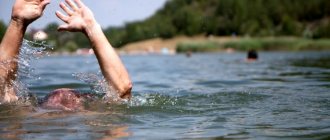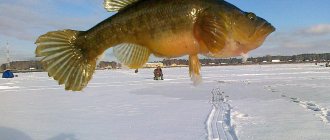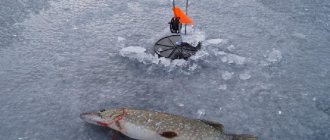Appearance of ice
With frosts, water bodies are not immediately covered with ice. This takes some time and also depends on various factors. The beginning of this process dates back to November, and everything ends by the New Year. The formation of ice is affected by the weather, because it is different every year.
At low temperatures, ice is created quickly, but when exposed to sunlight, it becomes porous with water. Its thickness may be necessary for skating, but it is not yet completely reliable, so it is important to maintain safety on the ice. As a rule, water bodies freeze unevenly.
First, the shallow water along the coast freezes, and then the process approaches the middle. This happens differently on different bodies of water; on rivers, ice appears more slowly, since everything is slowed down due to the current. Even within the same body of water, ice may have unequal thickness. This must be taken into account when heading to a frozen body of water.
Ice Formation
With the onset of frosty weather, you should not count on instant cover of water bodies with ice. This process is long and depends on many factors. It usually begins in November and continues until the New Year. It all depends on weather conditions, which are different every year.
At low temperatures at night, ice forms, but under the sun's rays during the day it begins to become porous from water that seeps through it. At the same time, the thickness may already be decent, but it cannot be called reliable, so it is important to follow safety measures on ice.
Usually, the freezing of reservoirs occurs unevenly over the entire area; first of all, freezing begins in shallow water, along the banks, and then the ice freezes in the middle. In different bodies of water, this process occurs at different speeds; for example, on rivers, ice forms more slowly, since this process is hampered by the current. Even on the same body of water, the ice may be of different thickness in different parts of it.
How to save life on ice?
Ice emergencies occur almost every year. Moreover, this could be skating, fishing or just a walk. It all has to do with the fact that not everyone follows ice safety rules. Due to careless behavior, there is a possibility of ending up in icy water.
The cause of many accidents is insufficient ice thickness. If it is not durable, you should not ride or go fishing on it. Usually people realize their mistakes already when danger arises. A person who finds himself on thin ice must carefully return. What makes ice assessment difficult is the snow on top, because no one knows what's underneath it.
Reminders and “Safety measures on ice”
11/22/2018 Safety measures on ice
14.1. On water bodies it is prohibited:
- operation of unequipped ice crossings;
- driving vehicles onto the ice outside equipped ice crossings;
- people entering the waters during periods freezing
, breaking up the ice cover of water bodies and
ice drift
; - going out on the ice, fishing and swimming in places where prohibiting safety signs are posted on water bodies.
14.2. When crossing a body of water on ice, you should use equipped ice crossings or paved trails, and if they are not available, make sure that the ice is strong using an ice pick. Testing the strength of ice by kicking is dangerous.
14.3. When driving on ice, you should avoid dangerous places and areas covered with a thick layer of snow. Particular care must be taken in places where there are fast currents, springs, bushes and grass protruding to the surface, streams flowing into water bodies and warm wastewater from industrial enterprises flowing in, ice is being harvested.
Ice with a greenish tint and a thickness of at least 7 centimeters is safe for crossing.
14.4. When crossing on ice, you should move one after another at a distance of 5-6 meters and, if necessary, be ready to provide immediate assistance to the person in front. Cargo transportation is carried out on sleds or other means adapted for these purposes with the largest possible area of support on the ice surface.
14.5. The use of ice skating areas on water bodies is permitted after a thorough check of the strength of the ice, the thickness of which must be at least 12 centimeters, and for public skating - at least 25 centimeters.
14.6. When crossing a water body on ice on skis, it is recommended to use a paved ski track, and if there is none, before moving on the virgin soil, you should unfasten the ski fastenings and remove the loops of the ski poles from your hands. The backpack or satchel must be carried on one shoulder. The distance between skiers should be 5-6 meters.
While moving, the skier going first checks the strength of the ice and monitors its condition by hitting his sticks.
14.7. When ice fishing, you should not make many holes in a limited area of ice or gather in large groups. Each fisherman is recommended to have personal rescue equipment with him:
- a cord 12-15 meters long, at one end of which a load weighing 400-500 grams should be attached, and at the other a loop should be made;
- a device with a sharpened rod to rest on the ice (hook), designed for self-rescue from an ice hole.
14.8. In places with a large number of fishermen during the period of intensive ice fishing, local governments of the Volgograd region must ensure that posts are equipped with life-saving equipment, communications equipment, electric megaphones and staffed by rescuers who constantly have information about the hydrometeorological situation in the area.
If there is a threat of ice breaking off from the shore, rescuers immediately inform fishermen about this and take measures to remove them from the ice.
14.9. Safety measures when using ice crossings.
14.9.1. Survey, design, construction and operation of ice crossings are carried out in accordance with the requirements of industry road standards (ODN 218.010-98).
Organizations operating ice crossings (crossing owners) must have permission to equip and operate them.
14.9.2. The operating hours of ice crossings are determined by the organizations operating them in agreement with executive authorities or local government bodies of the Volgograd region (depending on the status of the crossing). The order of traffic and the norms for the transportation of cargo and passengers are established by the administration of the crossing, taking into account the ice forecast and the maximum safe load on the ice.
14.9.3. Places allocated for ice crossings must meet the following conditions:
- roads and slopes leading to ice crossings must be improved;
- in the area of the ice crossing (to the left and right of it at a distance of 100 meters) there is no discharge of warm water and groundwater outlet, as well as gullies, lanes and areas for ice harvesting;
- Auto-drawn ice crossing routes are one-way. For oncoming traffic, a separate route is laid parallel to the first one, at a distance of at least 100 meters from it. The width of the route is set to 5 meters greater than the width of the largest cargo, but not less than 20 meters for crossing oil and gas winter roads. The ice crossing route should be as straight as possible and cross the river at an angle of at least 45 degrees. The minimum radius of curvature must be at least 60 meters.
14.9.4. The boundaries of ice crossings are marked every 25-30 meters with restrictive milestones, and restrictive signs are posted in places dangerous for traffic.
14.9.5. On both banks of the water body, at the descent to the auto-drawn ice crossing, parking areas for vehicles are equipped with a concrete ditch around it with a slope towards the removable waste tank, separate garbage collection boxes are installed, and boards with the inscription “Feed to a drowning person” are placed and with signs hung on them. lifebuoys, a safety rope 10-12 meters long. Next to the shields there should be rescue boards, a hook, a pole, a ladder, a log 5-6 meters long and 10-12 centimeters in diameter, used to help people when the ice breaks.
During periods of heavy vehicle traffic, mobile warming stations for people should be deployed at ice crossings and tractors with rigging should be on duty for possible evacuation of faulty vehicles from the working route.
Vehicles must enter the crossing at a speed of no more than 10 kilometers per hour. Cars must be driven in second or third gear. Vehicle doors must be open and driver and passenger seat belts unfastened.
14.9.6. To ensure the safety of people on the ice crossing, a departmental rescue post is set up, staffed by rescuers who know how to assist people in distress on the ice.
14.9.7. At the entrance to the crossing, a special board is installed, which contains information about what type of transport and with what maximum load is allowed to travel along this crossing, what interval of movement and what speed must be observed.
14.9.8. Every day in the morning and evening, and during the thaw and during the day, the thickness of the ice is measured and its structure is determined. Ice thickness is measured along the entire route and especially in places where the current speed and depth of the water body are greater. To avoid the insulation of ice and reduce its carrying capacity, snow is regularly cleared from the roadway of the crossing.
14.9.9. On ice crossings it is prohibited:
- punch holes for fishing and other purposes;
- move to places not intended for this purpose.
14.9.10. The operation of ice crossings is carried out after their technical examination.
Safety measures during ice harvesting work
15.5. When carrying out ice harvesting work, enterprises, institutions and organizations must fence off areas that are dangerous to people and display appropriate prohibitory safety signs on water bodies.
Safe ice
But even ice safety rules will not help if it is not thick enough. The ice cover must be able to withstand the loads that will be applied to it. In order for one person to pass the pond, the thickness of the ice must be at least 7 cm.
For the skating rink, you need to choose a place where the ice is 12 cm thick. And crossing in a group is possible only at 15 cm. Moving a car should be done with ice thickness of at least 30 cm. Safety measures on ice are always useful.
Precautionary measures
Adults should tell children that young ice that forms during mild frosts is dangerous. The ice surface is considered durable if its thickness is at least 7 cm. At an ice rink it should be 10-12 cm, with a large crowd of people - 25 cm. Even near the bank of a seemingly harmless river, the depth can be several meters.
Matte ice of a yellowish, greenish tint, which was formed as a result of thawing and subsequent freezing, is the strongest. The most dangerous color is white, formed by freezing snowflakes. If the ice crackles under your feet, it is better to move away from this place .
Memo
- If children are on the ice, the distance between them should be at least 3 m.
- You can’t walk on a frozen pond when it’s dark, there’s a snowstorm or it’s raining. Under such conditions, it will be very difficult for rescuers to provide assistance to those in trouble.
- You should not be on the ice alone. It is necessary for the child to be constantly in someone’s field of vision.
- Children should be reminded that ice thickness cannot be tested by kicking or hitting with a stick.
- If water appears on the frozen surface or cracks are visible, you must return immediately, preferably along the same route.
- If you have a backpack with you, throw it over your shoulder and take your hands out of your pockets. The skis are not secured, and the loops of the ski poles are left hanging freely. All this so that you can quickly free yourself from those things that will drag you to the bottom or impede your movements.
- The further from the coast, the thinner the ice and the stronger the current. A person who fails is quickly sucked in and it will be more difficult to save him.
- It is better to bypass areas where the surface is dark and covered with snow; ice holes are possible there.
- You should not play on ice near enterprises, factories where wastewater is discharged or where a river flows into a lake or another river.
- Places where there are frozen snags or boats, near pontoons and piers are considered dangerous. There is high turbulence up and down from the bridge supports; it is better to be 100 m away from them.
- In spring, the river is dangerous during ice drift. You cannot stand at the edge of a steep bank, ride on ice floes, or be on bridges or dams.
- You can only skate in special places that are checked and equipped.
Rules for safe behavior in spring for children
Dangerous ice
Experts can determine the reliability of ice even by its appearance. A yellowish or matte white surface is considered dangerous. Usually it has a porous structure, so it will not be durable. Because of this, it is not worth riding.
If the temperature does not drop below zero for several days, the strength decreases by 25%. Thin ice is usually found near thickets of reeds, bushes and trees growing near the banks. Careful behavior is required near ice holes, which may be invisible if covered with snow.
Reliability check
How to determine the strength of ice? You just need to step on it a little. If small radial cracks are noticeable and a crunching sound is heard, then you can walk on it, but it is important to maintain safety on ice. The check should not be performed by jumping or stomping.
If water appears at the top, then it is better not to walk in this area. When thin ice is discovered, you should not skate on it, because it is never possible to predict where exactly you might fall through. To avoid an accident, you need to return, stepping carefully with your feet, without lifting your legs high. In case of strong cracking, movement must be done by crawling.
How to make sure the ice is reliable
It is sometimes possible to find out whether ice is strong or not only by stepping on it. If, after several steps, small radial cracks are visible and a slight crunch is heard, then in principle you can walk on it, but maintain safe behavior on the ice.
Testing the strength of ice by jumping on it or stamping your feet is not at all prudent. If, after checking, water is found protruding from the top of the ice, it is better not to cross in this place. Safety on thin ice must be paramount. You can never predict where you might fall into icy water.
To prevent an accident, it is better to return back, carefully walking in your own footsteps and not raising your feet high. If a strong cracking sound occurs, it is better to crawl.
Behavior rules
In winter, it is imperative to maintain ice safety. To do this you need to follow simple rules:
- You should not go on ice at night, in fog, snow or rain.
- To cross to the other side, you must use ice crossings.
- You need to check the strength of the ice with a stick.
- Even with a small amount of water you cannot skate.
- The group needs to move at a distance of 5 meters from each other.
- It is better to cross waters on skis, but do not fasten the bindings.
- If there is some kind of load behind your back, then it must be placed on one shoulder.
- When traveling to a frozen body of water, you should take a rope with a loop and a weight with you, as these attributes will help save your life if you fall through the ice.
It is difficult to stay safe while intoxicated. But in case of danger, one must act decisively.
KomiOnline
Monday, January 15, 2021, 14:16 8370 1
What you should and shouldn’t do when crossing a river in winter and how to rescue those who have fallen into the water.
Specialists from the Russian Ministry of Emergency Situations prepared instructions and videos about the rules of behavior on rivers in winter, and also gave recommendations on how to protect yourself and children if someone is in danger. All this can be studied at the link. And then test your knowledge with a quiz.
Here are the main points that should be remembered by those who are planning to move along frozen rivers.
The safe ice thickness for one person is at least seven centimeters.
A water temperature of plus 2-plus 3 degrees proves fatal to a person in 10-15 minutes; at a water temperature of minus two degrees, death can occur in 5-8 minutes.
Durable ice is transparent, with a greenish or bluish tint. In open, snow-free areas, the ice is always thicker.
Thin ice is milky-cloudy, gray, usually spongy and porous; such ice collapses without warning cracking. It is also covered with snow (snow falling on newly formed ice, in addition to masking polynyas, slows down the growth of the ice cover).
The ice is thinner in currents, especially fast ones, in deep and windy places; over a shady and peaty bottom; near swampy shores; in places where underwater springs emerge; under bridges; in narrow channels; near places where warm and hot waters are discharged into bodies of water from industrial and municipal enterprises; in places where reeds, reeds and other aquatic plants grow.
Ice rules:
— You cannot go out on the ice at night or in poor visibility (fog, snowfall, rain).
— When crossing the river, you should use equipped ice crossings.
— If you are forced to cross a body of water, it is safest to stick to the beaten paths or follow an already laid ski track. But if they are not there, before going down onto the ice, you need to look around very carefully and outline the upcoming route.
— You cannot test the strength of ice by kicking it. If after the first strong blow with a ski pole even a little water appears, this means that the ice is thin and cannot be walked on. In this case, you should immediately follow your own trail to the shore, with sliding steps, without lifting your feet from the ice and placing them shoulder-width apart so that the load is distributed over a larger area. The same is done in case of warning cracking of ice and formation of cracks in it.
— Once on thin, crackling ice, you should carefully turn back and, with sliding steps, return along the traversed path to the shore.
— When going to a frozen body of water, you need to take with you a strong cord 20–25 meters long with a large blind loop at the end and a weight. The weight will help to throw the cord to a friend who has fallen into the water; the loop is needed so that the victim can hold on more securely by threading it under the arms.
— When crossing a pond in a group, it is necessary to maintain a distance from each other (5-6 meters).
— It is better to cross a frozen river (lake) on skis, and you need to unfasten the ski fastenings in order to quickly remove them if necessary; hold ski poles in your hands without putting loops on your hands, so that in case of danger you can immediately throw them away.
- You need to be especially careful in places covered with a thick layer of snow, in places with fast flows and springs, near bushes, sedges, grass protruding above the surface, in places where streams flow into reservoirs, and where water discharges from industrial enterprises.
— If you have a backpack, hang it on one shoulder, which will make it easy to free yourself from the load if the ice falls through.
— When fishing on ice, it is not recommended to make holes at a distance of 5-6 meters from one another. To avoid trouble, the fisherman must have a life jacket or bib, as well as a rope - 15-20 meters long with a loop at one end and a load of 400-500 grams at the other.
- You need to know that a person who falls into icy water can become numb in 10-15 minutes, and lose consciousness after 20 minutes. Therefore, the life of the victim depends on the intelligence and speed of action of rescuers.
— It is prohibited to : go out on the ice while intoxicated, jump and run on the ice, gather a large number of people at one point, go out on thin ice that has formed on fast-flowing rivers.
What to do when you fall through the ice:
- do not panic, do not make sudden movements, stabilize your breathing;
- spread your arms wide to the sides and try to cling to the edge of the ice so as not to plunge headlong;
— if possible, move to the edge of the ice hole where the current will not drag you under the ice;
- carefully, without breaking off the edge, without sudden movements, crawling with your chest, lie down on the edge of the ice, throw one and then the other leg onto it. If the ice holds up, slowly roll away from the edge and crawl towards the shore;
— you need to move in the direction from which you came, because there the ice has already been tested for strength.
Departure to the ice crossing
— To avoid accidents when driving through ice crossings, strictly follow the requirements of all information signs installed in front of ice crossings.
— Drive onto the ice slowly, without jolting or braking. Unfasten your seat belts.
— On the ice crossing it is prohibited to stop, move jerkily, turn around, overtake cars and refuel them.
— Do not allow loads that exceed the ice's carrying capacity.
— Moving vehicles in poor visibility (fog or snowstorm) is not recommended.
If the car ends up in the water , then you must:
— immediately leave the car while it is floating, through the side windows; It is advisable not to open the doors, as the car will sink faster;
- if the car goes under water, then before leaving the car, take a few deep breaths and get out of the car; If possible, get rid of “heavy” clothes (shoes, coats, jackets);
- you need to save children first, in this case, press the child with his back to you, cover his nose and mouth with your fingers, and float up.
How to provide first aid to a victim
- Arm yourself with any long stick, board, pole or rope. You can tie scarves, belts or clothes together.
-Crawl up to the hole very carefully, spreading your arms wide.
— Tell the victim by shouting that you are coming to his aid, this will give him strength and confidence.
- If you are not alone, then lie down on the ice and move one after another.
— Place skis, plywood or a board under yourself to increase the area of support and crawl on them.
— 3-4 meters away, hand the victim a pole, board, throw a rope, scarf or any other means at hand.
— It is unsafe to give a hand to the victim, since by approaching the ice hole, you will increase the load on the ice and not only will not help, but you yourself risk falling through.
- Carefully pull the victim onto the ice, and crawl with him out of the danger zone.
— Take the victim to a warm (heated) room. Help him: remove and wring out all his clothes, if possible, change into dry clothes and wrap him in plastic (a greenhouse effect will occur).
- Call an ambulance.
Photo by the press service of the Ministry of Emergency Situations in Komi
Share
Safety for children
Ice safety is especially important for children, as it is more difficult for them to navigate dangerous situations. After all, many kids love sledding, skating, and playing hockey. Parents and teachers should talk about the rules of behavior.
Children should not be on frozen bodies of water without adults. You should make sure that the ice has a thickness of at least 7 cm. And for group games, an indicator of 12 cm is required. Children should know that if the ice thickness is inappropriate, they must move in single file at a distance of no less than 5 meters from each other.
You should not step on ice if it is covered with snow, as there may be a hole there. In spring, children are prohibited from going to bodies of water. The ice is melting quickly, especially near the coast. If, nevertheless, it cracks and the child ends up in the water, in such a situation it is necessary to act decisively.
Instructions for TB on water bodies and in icy conditions
Instruction No. ___
Rules of behavior on the ice of reservoirs.
Every year, dozens of people die under the ice. Going out on the ice of a reservoir is always dangerous. The decisive factor in ensuring safety is the ability to predict extreme situations. When going out on the ice, you need to be prepared for any surprises. You should be especially careful after snowfall. Cracks, holes and ice holes will not be visible under the snow, and the ice under snow drifts is always much thinner. In such cases, you should move around holding a pole or long stick in your hands, using it to test the strength of the ice in front of you.
If you fall through the ice, a long stick or pole will help you get out of the hole. When approaching a dangerous area on skis, remove the backpack from one shoulder, unfasten the ski bindings, and take the poles in one hand. If necessary, you can quickly free yourself from the load and skis, and with the help of poles it is easier to get out of the hole if you end up there.
When going out on the ice you need to remember:
— safe ice thickness for one person is at least 7 cm;
— safe ice thickness for crossing on foot is 15 cm or more;
— safe ice thickness for vehicles to pass is at least 30 cm.
Ice rules:
1. Under no circumstances should you go out on the ice at night or in poor visibility (fog, snowfall, rain).
2. When crossing the river, use ice crossings.
3. You cannot test the strength of ice by kicking it. If, after the first strong blow with a log or a ski pole, even a little water appears, this means that the ice is thin and cannot be walked on. In this case, you should immediately follow your own trail to the shore, with sliding steps, without lifting your feet from the ice and placing them shoulder-width apart so that the load is distributed over a larger area. The same is done in case of warning cracking of ice and formation of cracks in it.
4. When crossing a pond, a group must maintain a distance from each other (5-6 m).
5. If there is a load, hang it on one shoulder, this will make it easy to free yourself from it if the ice falls under you.
6. We kindly ask parents: do not let children go on the ice (fishing, skiing and skating) unattended.
If something goes wrong:
- Don't panic.
“You don’t need to flounder and lean your whole body on the thin edge of the ice, as it will break off under the weight of your body.”
-Spread your arms wide so you don't plunge headlong into the water
- Rest your elbows on the ice and, bringing your body into a horizontal position, try to throw the leg that is closest to its edge onto the ice, turn your body to pull out the other leg and quickly roll out onto a solid surface;
-Without sudden movements, crawl as far as possible from the dangerous place in the direction from which you came;
-Call for help.
-When holding yourself on the surface of the water, try to expend a minimum of physical effort on this.
-While afloat, you should keep your head as high above the water as possible.
Failure to comply with safety rules at water bodies often causes death and injury to people.
Instruction No. ___
Rules of conduct in case of ice
Black ice is ice or a layer of snow that has been compacted until it becomes hard and creates a slippery surface. Black ice occurs where there was water before the frost, or where, due to traffic or a large number of pedestrians, the fallen snow becomes compacted. Most often this happens on roadways and sidewalks. According to statistics, about 40% of all road accidents in winter are caused by ice and snowfall. The main driving conditions for drivers are caution, low speed and extreme caution. A pedestrian in icy conditions faces two dangers: slipping and falling or getting hit by a car. With the onset of cold weather, the number of street injuries increases: bruises, dislocations and fractures. According to doctors, on such days the number of victims doubles.
To reduce the likelihood of falling, you must follow the following rules of behavior in icy conditions:
1. Choose non-slip shoes with microporous soles, avoiding high heels.
2. Watch your step, try to avoid dangerous places. If it is impossible to get around an icy “puddle,” then move along it like a skier, in small sliding steps.
3. Be extremely careful on the roadway: do not rush and, especially, do not run.
4. Try to avoid all places with an inclined surface.
5. You should step on the entire sole, slightly relax your legs at the knees.
6. Keep your hands free if possible; try not to carry heavy bags, do not keep your hands in your pockets - this increases the likelihood of falling.
7. If you slip, sit down to reduce the height of your fall. At the moment of falling, try to group yourself and, by rolling, soften the blow to the ground. Don't try to save things you're carrying in your hands. Take your time to get up, check yourself for injuries, ask passers-by to help you.
Remember:
Falling on your back or face up is especially dangerous, as a concussion can occur.
If you are injured, be sure to consult a doctor for medical attention.
First aid
Every person needs to be safe on ice. This guide will help you know the basic rules that will help you avoid dangerous situations:
- You have to crawl to help a failed person.
- You need to give him a scarf, stick or other similar things.
- Then the person must be carefully pulled onto the ice, without making sudden movements.
- When he is rescued, first aid should be provided, which involves warming him up and changing him into dry clothes.
It is important that no one in the group gets confused, but begins to act decisively. After all, help in such a situation must be provided immediately.
If it was not you who failed, but someone else
They try to remove the victim from the water using a rescue line. This is a long rope with heavy floats and a loop at the end. Anyone caught in the wormwood ties himself or his hands, after which he is pulled out. In a real situation, the role of a rescue line can be played by scarves tied together, a sled rope, the sled itself, skis, ski poles, a pole or a belt. To save a friend, you can use any available means.
Important
However, you must not forget about your own safety. You must not approach the edge of the ice. You need to crawl to the victim, using a board, skis, or ladder if possible. The main help is to calm your friend down, call adults for help, call rescuers.
If trouble happens while walking with a group, you can form a chain of several people. One is holding the other by the ankles. The one who is closest to the victim holds him and tries to pull him onto the ice. The victim must be dragged, not carried, so there is less load on the ice.
Rules of behavior in a physical education lesson
Warnings
- The rescued person should not be warmed or rubbed too quickly. Warm the injured person with dry clothing and warm drinks.
- It is dangerous to pull the victim out of the ice hole by the hand; you may end up under the ice yourself.
- Children should not organize a rescue operation on their own; it is better to report the incident to the rescue service as soon as possible.
What to do if no one is around?
It is important to maintain self-control and not panic. It is necessary to take a horizontal position and try with all your might to get to the surface. When the current pulls you under the ice, you need to lean against the edge with all your strength and call for help.
When moving, the backpack should be on one shoulder, since it can be easily thrown to the side when falling through. It is also necessary to prepare in advance for yourself rescue items that you can create yourself. For example, nails are wrapped with electrical tape to create something like a handle through which a cord is passed. This device will help you escape. You can come up with other means. Any sharp objects that can catch on the ice usually help.
Safety regulations
In addition to walking, they move around the reservoir on skis, snowmobiles and along specially equipped crossings by car. In these cases, the minimum layer of ice cover is set at 8, 15 and 30 cm, respectively. Winter fishing is carried out subject to the rules that protect anglers from unforeseen situations. The code of conduct prescribes:
- step on the ice, having first made sure of its strength,
- move along a body of water along paths trampled by other people - they mean that the path is safe,
- check the strength of the cover using a stick or pick, if no traces of movement are observed,
- return when you find water on the ice or hear a characteristic crackling sound,
- move quickly and calmly away from the cracks that have appeared with a sliding small step, without lifting your feet from the surface and not stopping until you reach a safe place,
- bypass areas with a concentration of fishermen - additional weight will cause cracks to appear,
- postpone going ice fishing if there is fog, rain or snowfall, do not go out to the reservoir at night,
- stay away from ice holes, ice holes and areas with rapid currents,
- Eliminate checking ice strength by jumping or kicking.
If a situation arises when, when moving a considerable distance, the crust becomes weak, you should lie down, spread your legs wide and crawl from the weak point towards the shore. Once in the water, there is no need to panic: throw off things that are preventing you from getting out onto the ice, stay on the surface and loudly call for help, without stopping trying to leave the hole.
A drowning person needs to be given a pole or a rope, crawl closer to the hole and help the drowning person. On ice, it is advisable to change the victim into dry clothes, give him a hot drink and call an ambulance.
Ice fishing rules
Many men prefer winter fishing, but it is very dangerous, especially during the thaw period. It is important to follow basic safety rules. Winter fishing should be carried out in familiar places, where the depth is no greater than a person’s height. It is also important to learn how to recognize security.
You also need to be careful when descending from the shore onto the ice, as it may be weakened. There is no need to make ice holes nearby. It is prohibited to sit in a group in a small area. If, when making a hole, water comes out of it, then this is a dangerous place, it is better to leave it.
You need to take sharp objects with you that will be useful for rescue. Only by following these simple rules will winter fishing be without negative consequences. Safety rules must be followed by children and adults. Then you can practice any winter sport.
Settlement news
Winter is a wonderful time! There is sledding, skiing and skating, simple snowball fights and much, much more. One of the most popular winter activities is winter ice fishing. However, when choosing just such a pastime, everyone must understand and be fully aware of the risk that he is taking on.
The fact is that ice on reservoirs is a high-risk area. A huge number of people die every year precisely because of non-compliance with safety rules when being on the ice of a reservoir. But these are not only fishermen who are interested in ice fishing, these are also children who decided to play on the ice or skate on it, and just those who decided to take a shortcut and walk on the ice.
Ice on reservoirs is treacherous and poses a huge danger. The fact is that bodies of water freeze unevenly, which means the thickness of the ice along its entire length can vary over a very wide range. Thus, if you went out on the ice in a place where its thickness was twenty centimeters, then nothing guarantees you that after a few meters you will not end up in an area with ice two centimeters thick. And ice this thick can hardly support an adult.
So what should you do if you find yourself in such a situation?
The only thing you definitely shouldn’t do is panic. Once you panic, your chances of a successful rescue quickly decrease. If you feel the ice beneath you getting thinner and starting to crack, you need to slowly and carefully return to where the ice was thicker. In this case, you cannot start running quickly on the ice. This behavior can only provoke a rapid cracking of the surface.
What to do if you do fall through the ice?
The first thing to do is call for help. It is enough to spend a few minutes in ice water for the body to be cooled to a state from which it is no longer possible to restore all the vital functions of the body. However, in this situation it is especially important that the person who comes to help knows how to do it correctly. To pull out a person who has fallen through the ice, under no circumstances should you approach the edge of the ice hole. After all, if the rescuer fails to reach the victim, then it is unlikely to help anyone. It will only complicate the rescue and put both of them at even greater risk of death. You need to find a stick or use clothes. Lying on your stomach (this puts less pressure per unit area of the ice surface, which means there is less chance of further ice breaking), you need to hold out a stick or clothing to the victim so that he can grab onto it. In this case, the second end must remain in the hands of the rescuer. It is necessary to act quickly, but without panic and fuss. After pulling the victim out of the hole as quickly as possible, take him to a safe place and call an ambulance.
While waiting for the professionals to arrive, it is necessary to provide first aid, remove wet clothes from the victim and give him dry clothes or wrap him in a blanket. The best solution would be to warm him with your body heat. If there is a hot drink, then it is necessary to give it something to drink. You should not immerse a person in a hot bath. Not even a healthy heart can withstand such a sharp temperature change. If it is possible to immerse a person in warm water, then it is best if the water is approximately body temperature, about thirty-seven degrees. Then, depending on the degree of warming of the victim, a small heating of the water is possible. And, of course, don’t forget about warm drinks.
Even if you immediately placed the victim in a warm bath and gave him warm tea, if he assures that he feels fine and nothing bothers him, you need to call an ambulance. The fact is that after a state of shock and everything that has been experienced, a person may simply not feel any changes that could happen to his body. And when he feels it, it may be too late. In this situation, an examination by a doctor, his examination and measurement of the most important vital signs of the body are simply necessary. After all, very often people who fall through the ice die even after they have already been rescued precisely because of hypothermia and failure of vital organs.
Winter is a wonderful time. And don't hibernate while waiting for summer. It is much better to enjoy all the pleasures that frost and snow have in store for us. However, never forget about safety rules. After all, if you follow them, you will protect yourself and your loved ones from misfortune, and winter will be associated only with wonderful entertainment.
- under no circumstances go out onto the icy surface of a reservoir if it is thin or loose, and water appears here and there;
- if you see that the ice under your feet is becoming thinner and begins to crack, you need to return to a safer place and leave the surface of the reservoir as quickly as possible;
- do not go out on the ice if you are alone and there is no one within sight who could come to your aid;
- under no circumstances jump on the ice, and you should also not run on it;
- if you are rescuing a person who has fallen through the ice, follow the instructions and do not panic.
These simple and understandable rules will help you maintain life and health and get only positive emotions from winter.
Department for Civil Defense and Emergency Affairs (845-2) 550-520











